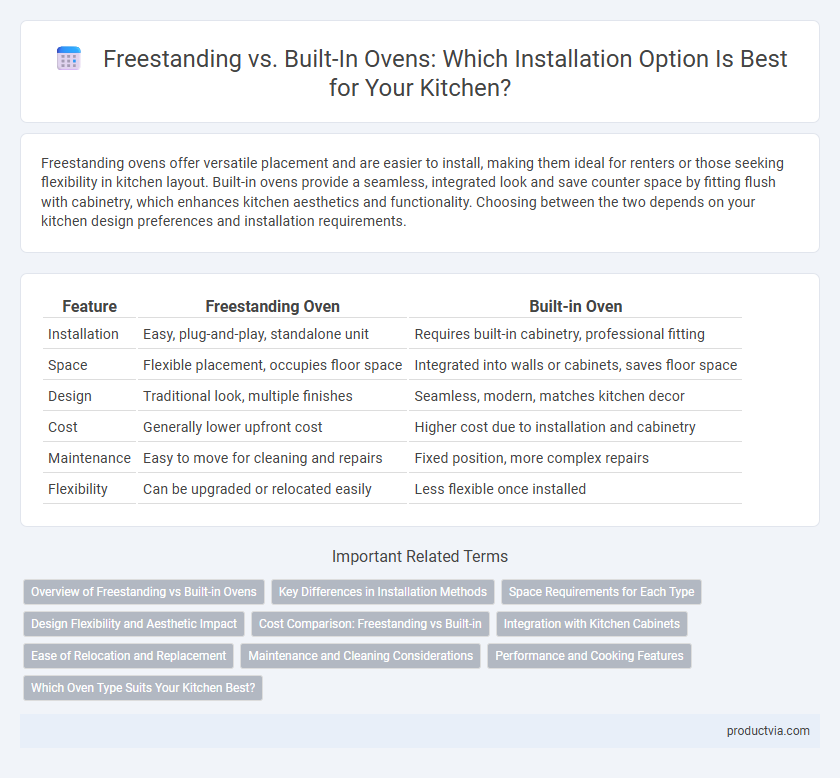Freestanding ovens offer versatile placement and are easier to install, making them ideal for renters or those seeking flexibility in kitchen layout. Built-in ovens provide a seamless, integrated look and save counter space by fitting flush with cabinetry, which enhances kitchen aesthetics and functionality. Choosing between the two depends on your kitchen design preferences and installation requirements.
Table of Comparison
| Feature | Freestanding Oven | Built-in Oven |
|---|---|---|
| Installation | Easy, plug-and-play, standalone unit | Requires built-in cabinetry, professional fitting |
| Space | Flexible placement, occupies floor space | Integrated into walls or cabinets, saves floor space |
| Design | Traditional look, multiple finishes | Seamless, modern, matches kitchen decor |
| Cost | Generally lower upfront cost | Higher cost due to installation and cabinetry |
| Maintenance | Easy to move for cleaning and repairs | Fixed position, more complex repairs |
| Flexibility | Can be upgraded or relocated easily | Less flexible once installed |
Overview of Freestanding vs Built-in Ovens
Freestanding ovens offer versatile placement options with integrated cooktops and sides for easy installation, ideal for renters or flexible kitchen layouts. Built-in ovens provide a sleek, seamless design that integrates into cabinetry, maximizing space and enhancing kitchen aesthetics in permanent setups. Choosing between freestanding and built-in ovens depends on available space, design preferences, and installation requirements.
Key Differences in Installation Methods
Freestanding ovens require minimal installation, simply plugging into an existing power source and fitting between cabinets, offering flexibility in kitchen layout. Built-in ovens necessitate precise cabinetry integration, often requiring custom measurements and professional installation to ensure seamless alignment and ventilation. The choice impacts kitchen design, with built-in models providing a streamlined look while freestanding models offer easier mobility and replacement.
Space Requirements for Each Type
Freestanding ovens require minimal installation space and can fit into any kitchen area with standard cabinet clearances, making them ideal for flexible kitchen layouts. Built-in ovens demand precise measurements and integration within cabinetry, necessitating dedicated wall or cabinet space to ensure proper ventilation and seamless design. Considering these spatial requirements helps optimize kitchen flow and appliance accessibility based on the oven type chosen.
Design Flexibility and Aesthetic Impact
Freestanding ovens offer greater design flexibility, as they can be placed anywhere in the kitchen without requiring custom cabinetry, making them ideal for remodels or rentals. Built-in ovens provide a seamless, integrated look with cabinetry, enhancing the kitchen's aesthetic appeal and modernizing the overall design. Choosing between freestanding and built-in ovens depends on the desired kitchen layout, space constraints, and visual continuity with other appliances.
Cost Comparison: Freestanding vs Built-in
Freestanding ovens generally cost less upfront, making them a budget-friendly option for kitchen installations. Built-in ovens often require additional cabinetry work and professional installation, increasing the overall expense. When factoring in installation fees and potential remodeling costs, freestanding models typically present a more cost-effective solution compared to their built-in counterparts.
Integration with Kitchen Cabinets
Freestanding ovens offer flexible placement options without requiring modifications to kitchen cabinets, making them ideal for renters or those seeking easy installation. Built-in ovens create a seamless look by integrating directly into cabinetry, enhancing the kitchen's aesthetic through customized alignment and uniform design. Cabinet integration with built-in ovens often maximizes counter space and ensures ergonomic height for improved cooking convenience.
Ease of Relocation and Replacement
Freestanding ovens offer superior ease of relocation and replacement due to their standalone design, allowing homeowners to move or replace the unit without altering cabinetry. Built-in ovens require precise installation within fixed cabinetry, making relocation or replacement more labor-intensive and costly, often necessitating professional adjustments. Choosing a freestanding oven provides flexibility for kitchen redesigns, while built-in models offer a seamless aesthetic but less convenience for future changes.
Maintenance and Cleaning Considerations
Freestanding ovens often allow easier access for maintenance and cleaning due to their detachable nature and space around the unit, enabling thorough cleaning of both the oven and surrounding areas. Built-in ovens, integrated within cabinetry, may require more effort to remove or service components and can accumulate grease and debris in seams and joints, demanding regular attention to prevent buildup. Choosing between freestanding and built-in models affects long-term upkeep efficiency, with freestanding designs offering more straightforward access but built-ins providing a seamless kitchen aesthetic.
Performance and Cooking Features
Freestanding ovens offer versatile installation options with easy mobility, while built-in ovens provide a seamless, integrated look that can enhance kitchen aesthetics. Performance-wise, built-in ovens often feature advanced cooking technologies like convection and steam options, allowing for precise temperature control and even heat distribution. Freestanding models typically prioritize ease of use with standard cooking modes, making them suitable for general baking and roasting needs.
Which Oven Type Suits Your Kitchen Best?
Freestanding ovens offer flexible installation and easy relocation, making them ideal for kitchens where adaptability is key, while built-in ovens provide a sleek, integrated look that maximizes counter space and complements custom cabinetry. Consider kitchen size, design preferences, and cooking habits: freestanding models suit smaller or rental spaces, whereas built-in ovens enhance streamlined layouts in modern kitchens. Understanding your kitchen's layout and how frequently you cook can guide the decision between the convenience of freestanding and the seamless aesthetics of built-in ovens.
Freestanding vs Built-in for installation Infographic

 productvia.com
productvia.com